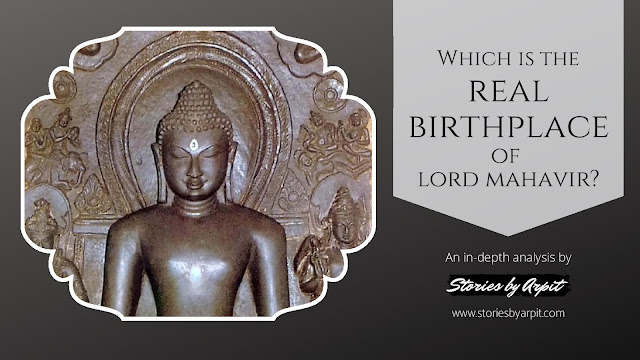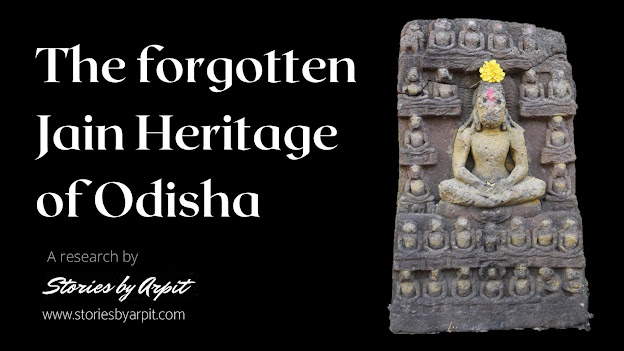Bengal is rich with history and so is Jainism. Although Jainism is not as widespread in Bengal as in Gujarat and Rajasthan, it too has some very beautiful and interesting stories to tell. Not to forget the contribution of Marwari Jains to Bengal, I write this post to highlight the contribution of the marwari jains in the development of Jainism along with its architectural heritage in Eastern India.
Murshidabad, the erstwhile capital of Bengal founded by Murshid Quli Khan, the nawab of Bengal in the early 18th century was at its peak in the early 19th century. Jains came to Murshidabad, drawn by the promise of trade and banking as the city had become the economic center of Bengal. Several families settled in the nearby twin towns of Azimganj & Jiyaganj which became the nucleus of the Murshidabad Jain community.
In course of time they acquired immense wealth, enabling them to construct many beautiful Jinalays (Jain temples) in these twin towns. At its peak, this community numbered about 100 Jain households. The five "heads" of this community were the Dugars, the Dudhorias, the Nahars, the Kotharis and the Nowlakhas.
There are fourteen Jain temples in these twin cities situated both sides of river Bhagirathi showcasing exemplary architectural beauty. These indo-mughal-colonial temples beautifully depict the amalgamation of Jain styles with the Muslim and European architecture.
The temples at Azimganj are dedicated to Shri Neminath Bhagwan, Shri Shantinath Bhagwan, Shri Chintamani Parshwanath Bhagwan, Shri Sumatinath Bhagwan, Shri Padmaprabhu Swami, Shri Sambhavanath Bhagwan, Shri Godi Parshvanath Bhagwan and Shri Sanwalia Parshwanath Bhagwan. Following is a brief account on each of the temples:
The Neminath Bhagwan Jinalay, close to the Bhagirathi river, built in Samvat 1943 is one of the most beautiful Jain temples in Azimganj. The temple's architecture stands out whith its 3 shikhara's and french style windows. The temple houses beautiful idols of the lord and is one of the best maintained in the town. The temple has been constructed in such a way that the outer Rangmandap receives sunlight glittering the entire temple. The sanctum sanctorum houses the Parikar-yukt pratimajis of Shri Neminath Bhagwan, Shri Parshwanath and Shri Mahavir Swami in a beautiful marble mandap.
 |
| Shri Neminath Bhagwan Jinalay |
 |
| Shri Neminath Bhagwan Jinalay |
 |
| Mulnayak Shri Neminath Bhagwan |
Shri Chintamani Parshwanath Jinalay was built in 1888 AD by the Manhot family. The idols brought in here are around 500 years old. The gates and statues in the temple are made of "Kasauti Pathar"- 'touch stone'( which was used to test the purity of gold). Also this temple is home to many beautiful idols made of various gemstones, many of them stolen in recent times. The temple has lost its glory due to passage of time and lack of maintenance. A single pujari takes care of hundreds of pratimaji's with meager resources. There are hundreds of Panch Dhatu idols in the temple which have been preserved well.
 |
| Shri Chintamani Parshwanath Jinalay |
 |
| Mulnayak Shri Chintamani Parshwanath Bhagwan |
 |
| Ratna Pratimajis - Pratimaji's made of Rare Gemstones |
 |
| Gateways made out of Kasauti Patthar- Touch Stone |
 |
| Remains of stolen Idols |
 |
| Idols made out of Panch Dhaatu |
 |
| Pratimaji's made out of Kasauti Patthar- Touch Stone |
Shri Padmaprabhu Swami Jinalay was constructed in 1880 AD by Yati Bijay Chandji.
 |
| Shri Padmaprabhu Swami Jinalay |
Shri Sumtinathji Jinalay was built in 1856 AD by Uttam Chandji Nahar and was rebuilt by Setab Chandji Nahar in 1897 AD. The temple lacks maintenance and the ancient artifacts stored here -rock cut inscriptions and carvings gather dust.
 |
| Shri Sumatinath Swami Jinalay |
 |
| Ancient Shila-Lekhs (Rock Cut inscriptions) |
 |
| Ancient Carvings from Stupas |
Shri Sambhavnathji Jinalay built in 1886 AD by Rai Dhanpat Singhji Dugar is the largest temple in the town. The towering idol of Shri Sambhavnath Bhagwan leaves one mesmerized! Around 60 kms of railway tracks were built by Shri Dhanpat Singh Dugar to carry this huge Pratima ji from Nalhati to Azimganj
 |
| Shri Sambhavnathji Jinalay |
 |
| Shri Sambhavnathji Jinalay |
 |
| Mulnayak Shri Sambhavnathji |
Shri Shantinathji Jinalay, which lies in the market area was constructed in 1873 AD by Gulab Kumari Bibi. One of the idols here is very ancient and belongs to Samvat 1510.
 |
| Outer Facade of Shri Shantinathji Jinalay |
 |
| Mulnayak Shri Shantinath Bhagwan |
Shri Sawalia Parshwanath Bhagwan Jinalay, Shri Godi Parshwanath Bhagwan and Dadawari in the Rambagh area was built in 1870 AD This temple complex also houses statues from Jangipur, Kiaganj and Cossimbazar. The dadawadi houses sphatik charan paduka of Dada Gurudev.
 |
| Shri Godi Parshwanath Bhagwan |
 |
| Shri Sawalia Parshwanath Bhagwan |
 |
| The Bhagirathi river separating the twin towns |
Across the river, the temples at Jiyaganj are dedicated to Shri Vimalnath Bhagwan, Shri Sambhavnath Bhagwan and Shri Adinath Bhagwan.
 |
| Shri Vimalnath Bhagwan Jinalay |
 |
| Shri Vimalnath Bhagwan Jinalay |
 |
| Mulnayak Shri Vimalnath Bhagwan |
 |
| Mangal murtis |
 |
| Shri Sambhavnath Bhagwan Jinalay |
 |
| Shri Sambhavnath Bhagwan |
 |
| Shri Adinath Bhagwan |
Near to the twin towns lies the
Kathgola Tirth built by Rai Laxmipat Singh Bahadoor Dugar in the 19th century who belonged to the family of Jagat Seths. The place is called Kathgola as it was once famous for its wooden colored roses : Kasht (wood) & Golap (Rose).
The family of the Jagat Seths were devout Jains and came to prominence for the vast wealth they accumulated as the Nawab's bankers. It was during the rule of Siraj ud Daulah the then Jagat Seth played a pivotal role together with Siraj's maternal uncle Mir Jafar, Umichand and Rai Durlabh in the determining the outcome of the battle of Plassey in 1757. At Plassey, Robert Clive, commanding a troop of 400 riflemen of the East India Company defeated the forces of an utterly debauched and degenerate Siraj ud Daulah.
 |
| Shri Kathgola Tirth |
 |
| Shri Kathgola Tirth |
The temple dedicated to the first tirthankara, Shri Adinath Bhagwan is built in an area covering 30 acres. The gardens, ponds, marble gazebos and statuettes enhance the beauty of this temple. Close to the temple lies the palace of Jagat Seths which has been converted into a museum.
 |
| Mulnayak Shri Adinath Bhagwan |
 |
| Entrance to the palace gardens and the temple |
 |
| The step well |
 |
| Beautiful marble statues adorning the gardens |
 |
| Intricately carved gateways |
 |
| The Kathgola Palace |
 |
| Marble figurines outside the Jinalay |
These hidden treasures have long been ignored by the Jain community. Travelers are unaware of such beautiful places and lack of comforts is also a cause for the low footfalls. Some of the tirths are not in perfect health and it is time we preserve the heritage built by our forefathers.
















































Lovely Bro !!
ReplyDeleteThank you bro
DeleteVery well written article. I loved the balance of architectural details and history. And of course the best was knowing more about our lost and ignored heritage.
ReplyDeleteThank you !
DeleteVery well written article. I loved the balance of architectural details and history. And of course the best was knowing more about our lost and ignored heritage.
ReplyDeleteSome of our Acharyas are in that belt. They can be approached for for furthering the cause of preserving these monuments.
Thank you sir
DeleteBahoot Khoob.. very informative article... jai jinendra..
ReplyDeleteSome mistake...Bimalnath Swami temple shown as Sambhavnath Swami...even the idols vice versa...of Jiaganj...
ReplyDeleteIs there any dharamshala in jiaganj..??
ReplyDeleteJai Jinendra. Excellent information. I have been to Jiyaganj and Azimganj some 30/32 years back. Jinalays at both the places are very very beautiful, I had stayed in Dharmashala at Jiyaganj I suppose. Some 40/50 years back yatras for Shikharji conducted from Gujarat and Mumbai by Bhagubhai and Balabhai etc. use to cover all these three places. These neglected places need special attention by the Jain Community and specifically by Guru Bhagwants, otherwise we will loose these Heritage of ours like we lost our beautiful Jinalays at Tharparkar, Lahore, Gujaranwala etc.
ReplyDeleteThanks a lot to Arpitbhai. Based on his blog, we decided to visit Azimganj/Jiaganj. We had no idea whom to contact. We just followed this blog and arrived at Azimganj Railway Station. The journey from thereon was completely mesmerizing. We visited this amazing place in Jan 2025. Here is a small itinerary that we followed,
ReplyDelete1. Arrive either at Azimganj Junction or Azimganj city. The stay at Shwetambar kothi is very comfortable and scenic. The kothi is almost 1.4 Km from Azimganj Junction and 300 MTRS from Azimganj city. There are ample toto (Electric Ricks) available outside station. It would be convenient if you called the manager/pujari Gautambhai - 86375 56654 in advance for rooms. Although it's quite spacious, due to some big groups, there might be room shortages.
2. The manager is very helpful in arranging toto for full day which will take you to 9 temples in Azimganj. Although Arpitbhai has done marvelous job of describing temple architecture in detail, but words do injustice to this untouched beauty. Pooja can be done at all temples. It might take 3-4 hours to cover all. The cooking lady at kothi is very decent and prepared food as per our choice. One can also cook their own food. There is a small market in walking distance where all vegetables and fruits are available.
3. Take a ferry to Jiaganj the next day. Toto can be booked which will take you across in ferry. There are 6 temples in Jiaganj and few historical places.
Details on Jiaganj to follow in next